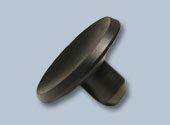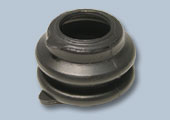Transfer Molding
Transfer molding is an extension of compression molding optimized for higher-volume production runs. Unlike compression molding, transfer molding uses a third plate, in addition to the product cavity plates, to push a quantity of uncured rubber into the product cavities. In its most basic form, a transfer mold consists of a top plate, which acts as a plunger that pushes uncured rubber into the middle plate, which contains a transfer pot and holes through which the rubber flows. The opposite side of the middle plate contains the upper half of the molding cavities; while, the bottom plate contains the lower half of the molding cavities. In operation, uncured rubber is placed into the transfer pot and the mold is closed. When pressure is applied by a hydraulic press, the plunger forces the uncured rubber in the transfer pot, through the sprues, into the product cavities where heat from the press vulcanizes the product.
Advantages of Transfer Molding:
• Shorter production cycle
-Compound preparation time is reduced (less cutting).
-Product finishing time is reduced (less flash).
Disadvantages of Transfer Molding:
• Expensive tooling
-Molds tend to be complex.
• More compound waste
-The plunger/pot system results in pot-rind waste.
When quoting a new job, if the molding technology is not specified, we can assist in selecting the most appropriate technology in order to optimize the tool for the production run at hand. Please, feel free to contact us for more information.
|



|